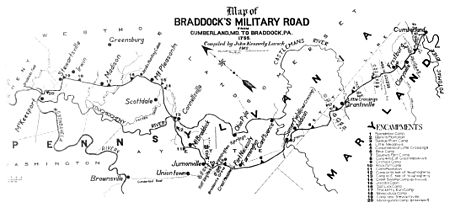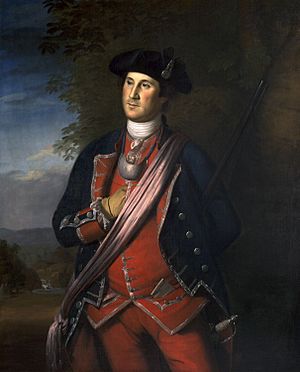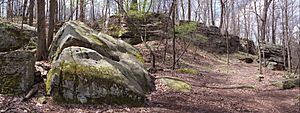Battle of Jumonville Glen facts for kids
Quick facts for kids Battle of Jumonville Glen |
|||||||
|---|---|---|---|---|---|---|---|
| Part of the French and Indian War | |||||||
 Washington's map of the Ohio River and surrounding region containing notes on French intentions, 1753 or 1754 |
|||||||
|
|||||||
| Belligerents | |||||||
| Mingo (Ohio Iroquois) | |||||||
| Commanders and leaders | |||||||
| Strength | |||||||
|
35 soldiers | ||||||
| Casualties and losses | |||||||
|
reports vary; most were captured or killed | ||||||
The Battle of Jumonville Glen was the very first fight of the French and Indian War. It happened on May 28, 1754, in what is now Fayette County, Pennsylvania. A group of soldiers from Virginia, led by Lieutenant Colonel George Washington, teamed up with some Mingo warriors. Their leader was a chief named Tanacharison, also known as the "Half King."
They ambushed a small group of 35 Canadien soldiers. These French soldiers were led by Joseph Coulon de Villiers de Jumonville. This battle was a big deal because it helped start a much larger war.
| Top - 0-9 A B C D E F G H I J K L M N O P Q R S T U V W X Y Z |
Why the Battle Happened
For many years, British and French traders met in the Ohio Country. This area is now western Pennsylvania. Both Britain and France claimed this land. In 1753, France started building forts there. They wanted to make sure the British traders left.
The Native American tribes in the area also noticed this. Some tribes, like the Mingo, preferred trading with the British. Tanacharison, a Mingo chief, became very anti-French. He felt disrespected by a French commander.
The governor of Virginia, Robert Dinwiddie, sent a young officer named George Washington to tell the French to leave. Washington was a major at the time. The French commander politely told Washington that he would not leave.
Washington went back to Virginia and told Governor Dinwiddie. The governor then made Washington a lieutenant colonel. He ordered Washington to gather soldiers to build a fort. This fort would be at a place called the Forks of the Ohio. Today, that spot is Pittsburgh.
A small group of British workers started building a storehouse there. But in April 1754, a large French force arrived. They had about 500 soldiers. The French told the British workers to leave, and they did. The French then built their own fort there, called Fort Duquesne.
Getting Ready for the Fight
In March 1754, Governor Dinwiddie told Washington to go back to the frontier. He was told to protect British settlements. Washington was also told to fight anyone who tried to stop them. This order was given without the British government in London knowing about it.
Washington left with about 160 men. Along the way, he learned that the French had taken the Forks of the Ohio. He also got a message from Chief Tanacharison. The chief promised to help the British with his warriors.
Washington decided to keep going. He reached a place called the Great Meadows. It was about 37 miles (60 km) south of the Forks of the Ohio. He started building a small fort there. This fort would later be known as Fort Necessity.
The French commander, Contrecœur, had orders not to attack first. On May 23, he sent Joseph Coulon de Villiers de Jumonville with 35 soldiers. Their job was to find Washington and tell him to leave French territory. This was similar to the message Washington had given the French earlier.
On May 27, Washington learned that a group of about 50 French soldiers was nearby. He sent 75 men to find them. That evening, Washington got a message from Chief Tanacharison. The chief had found the French camp and wanted to meet.
Washington took 40 of his men to meet Tanacharison. The Mingo chief had 12 warriors with him. After talking, they decided to attack the French camp. They took positions behind rocks around the camp. They saw about 40 French soldiers.
The Battle Begins
What exactly happened next is still debated by historians. But most agree on a few things. The fight lasted about 15 minutes. Jumonville was killed. Most of his men were either killed or captured.
Washington wrote in his diary that his men fired first. He said they killed Jumonville and nine others. They wounded one and captured 21 prisoners.
A French report said that Jumonville's group was surrounded. The English fired two rounds. Jumonville tried to tell them to stop, saying he had a message. But he was killed by a musket shot while they were reading the message.
Another account, from a British soldier not present at the battle, said the French were surrounded. Some were still sleeping. When one Frenchman fired a gun, Washington ordered his men to fire. Many French soldiers were killed, and the rest tried to run. But the Native American warriors had gone around the French. So, the French ran back to the English and gave up their weapons.
One Mingo follower reported that after Washington's men fired, Chief Tanacharison went up to the wounded Jumonville. He reportedly said, "You are not yet dead, my father!" and then killed him. This was seen as a ritual killing.
The Virginians had only one soldier killed and two or three wounded.
What Happened Next
After the battle, Washington went back to the Great Meadows. He continued building Fort Necessity. The dead soldiers were left on the field or buried.
About a month later, on June 28, 1754, Jumonville's brother, Louis Coulon de Villiers, led a large force of 600 French, Canadien, and Native American soldiers from Fort Duquesne. On July 3, they attacked Fort Necessity. Washington and his men were forced to surrender.
The document Washington signed to surrender was written in French. Washington did not read French. The document said that Jumonville and his men were "assassinated." This made it seem like Washington had ordered Jumonville's killing.
The War Grows
When news of these battles reached England, the British government decided to send a large army. Major General Edward Braddock was chosen to lead this army. He was defeated in another battle, the Battle of the Monongahela. The French kept control of Fort Duquesne until 1758.

France also sent many more troops to Canada in 1755. This led to more French victories. Eventually, Britain and France officially declared war on each other in 1756. This marked the start of the Seven Years' War, a huge global conflict.
Legacy of the Battle
Part of the battlefield, along with the Great Meadows where Fort Necessity was, is now a preserved area. It is called Fort Necessity National Battlefield. There is also a Christian retreat center nearby named after Jumonville. Groups like the Braddock Road Preservation Association work to teach people about the French and Indian War history of the area.
See also
 In Spanish: Batalla de Jumonville Glen para niños
In Spanish: Batalla de Jumonville Glen para niños



